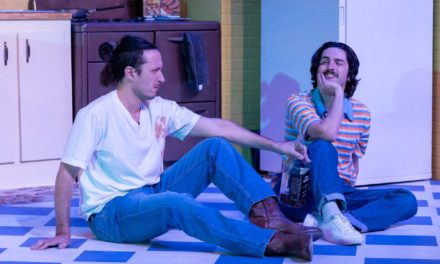SALT LAKE CITY — Halo punches the at glove of her trainer, Gina, with everything she’s got. “Be nice! Be good! Don’t be so emotional!” she rages as each thud lands hard. The two circle around and around, jabbing with their voices and arms as they lay bare their frustration and exhaustion with the external demands of womanhood. In this scene, playwright Stephen Spotswood reveals the thesis statement of Girl in the Red Corner. Westminster College’s production lands all the right punches. Through the life of Halo, a woman stranded by a lifetime of disadvantage, the playwright sheds light on the difficult realities faced by the working poor. The script deftly maneuvers around hard-hitting topics including workplace harassment, domestic violence, and drug and alcohol abuse without becoming heavy handed. The characters are multifaceted, and despite their many flaws, they are likable. The production does not shy away from the darkness the characters are confronting, but neither does it get lost in the darkness.

Show closed October 19, 2019.
As the play opens, the scene introduces Halo: recently divorced, unemployed and struggling to keep the peace while beset by the loving demands of her mother, sister, and (always offstage) twelve-year-old niece. This family of women is tough-talking and accustomed to fighting for everything they have, be it decent treatment at work, their difficult marriages, or their relationships with each other. Maggie Minshew’s performance highlights the shifting balance of Halo’s vulnerabilities. It’s clear early on that Halo is not a quitter, but that doesn’t mean anything comes easy for her. Halo makes the decision to dedicate herself to endless hours of training in mixed martial arts fighting, and as she develops physical strength, she also develops the mental and emotional strength needed to assert herself in her work and family life.
The cast of seven works together beautifully to create a performance with fluid transitions from scene to scene. Their movement is expertly choreographed around the bare octagonal stage. Using nothing more than stools they beat out the rhythm of the play with dance-like precision. Under Amanda Hayter’s direction, the action is as relentless and thrilling as Halo’s training. Karlie Galloway, in the role of Halo’s trainer, Gina, makes use of her small stature to highlight Gina’s shocking strength and fortitude. Costume designer Victoria Bird leaves the actors’ bodies appropriately exposed as the vulnerable sacks of meat they are, and it was clear from the scrapes and bandages on the feet of the actors on closing night that Minshew and Galloway have given this production everything they’ve got.
In supporting roles, Samantha Miller as Halo’s sister and Ryan Klenz as Halo’s brother-in-law, were particularly excellent. Along with Kate Slick as Halo’s mother, the tricky timing and pace of family arguments was perfectly and passionately executed. Slick has excellent comedic delivery and was admirable in her effort to realistically age herself into a woman more than twice Slick’s own age, but this transformation was an essentially insurmountable challenge. Hannah Orr and Carter Wagstaff in roles that provide additional comic relief were enjoyable, but also less believable because of their youth. Indeed, the script is so good that I did find myself wishing to see it performed by actors with more experience and maturity. Still, it is unfair to fault these excellent student performers for what is beyond their control.
Spencer Brown’s lighting and set work effortlessly along with Sam Allen’s sound design to compliment the actors’ work. The simplicity of the production matches the raw emotional quality of the story. However, one moment that fell flat was the climactic scene of the production. Sharp changes in lighting, sound, and slow-motion movement were used to create tension and heighten the emotional experience. This type of cinematic special effect is difficult to pull off with the most advanced technical equipment and highly skilled actors and technicians. Though I could sense exactly what the moment was aiming at, it failed due to imperfect execution. In fact, this moment when Halo physically confronted her demons, or her fears, or something similarly obscure, is probably the weakest moment of the script, and the more I consider it the less sense it makes.
Despite the climactic scene, I found Girl in the Red Corner compelling as a social commentary and family drama even more so than as the hero narrative that it sets out to be. I applaud the actors and designers for this excellent production that pulls no punches.

This review generously sponsored by a grant from the Salt Lake County Zoo, Arts, and Parks program.





